
Visions of Barsoom: 100 Years of John Carter™ :: February 2012
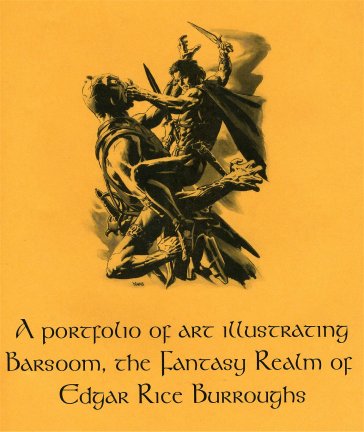
In Honor of the 100th Anniversary of the
First Publication of "A Princess of Mars."
By Dr. Robert Zeuschner
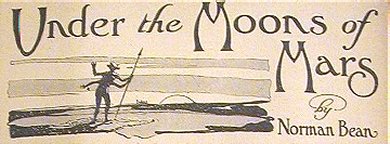
The first tale of Barsoom was in the February 1912 issue of All-Story magazine, entitled "Under the Moons of Mars." It was published under the pseudonym "Norman Bean" (but Burroughs had intended it to read "Normal Bean"). The only illustration found in the six issues of the serial was a small title decoration by artist F. W. Small portraying a lone green six-limbed warrior.
There exists many fine pieces of art inspired by the Mars created in the fertile imagination of Edgar Rice Burroughs. This portfolio includes 25 images, some quite rare, others not so rare. The majority of the images are the property of Edgar Rice Burroughs, Inc. and used by permission. The plates range from 1913 to the last plate finished in 2011. We wish we could have included some of the concept art for the Disney John Carter movie, but none was available for our use.
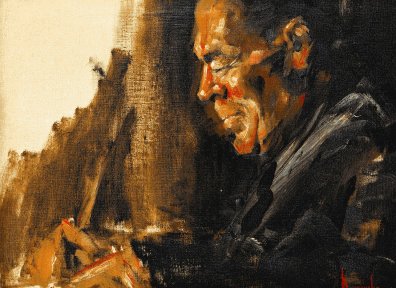
The first plate in this portfolio is a painting of Edgar Rice Burroughs (1875-1950), the author and creator of Barsoom, painted by his son, artist John Coleman Burroughs (1913-1979), who illustrated twelve books written by his father. Edgar Rice Burroughs, Inc. owns several pieces by John Coleman Burroughs. Presently this painting hangs in the office of Jim Sullos, the president of Edgar Rice Burroughs, Inc.
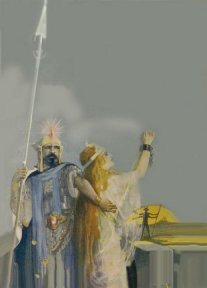
From the very beginning, readers responded to the creative imagination of Edgar Rice Burroughs, and the worlds which he was able to create. The very first magazine to feature a full-color cover scene of Barsoom was the 1913 All-Story "Warlord of Mars," the third in the Barsoom series. The artist, Fred W. Small, chose a scene which occurs at the end of Warlord of Mars. The lovely Dejah Thoris is the captive of Salensus Oll, the Jeddak (ruler) of the North. In the book, her hands are manacled to prevent her from escaping the lustful evil plans of the ruler. The magazine is from the collection of Bob Zeuschner. The scan was improved by Bruce Bozarth.
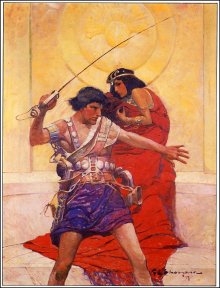
The talented Brandywine school artist Frank E. Schoonover (1877-1972) created this classic image of John Carter battling to protect his princess, Dejah Thoris. It is likely that the art was created in late 1916 or early 1917. This was used as the dust jacket art for the first edition of the first hardback set on Barsoom, A Princess of Mars printed October, 1917.
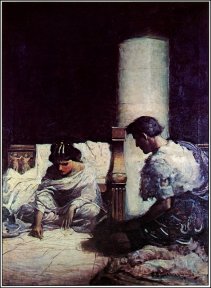
In interior artwork for chapter 16 of A Princess of Mars, Frank E. Schoonover gave us an illustration of Dejah Thoris scratching a map for John Carter:
"... taking a great diamond from her hair she drew upon the marble floor the first map of Barsoomian territory I had ever seen. It was crisscrossed in every direction with long straight lines, sometimes running parallel and sometimes converging toward some great circle."
The original painting is in the collection of Dr. Brad Vinson, and used by permission.
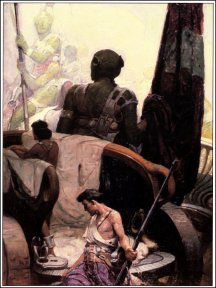
Frank E. Schoonover has illustrated a scene from ch. 14 of A Princess of Mars. Dejah Thoris stands on a chariot, chained by her captors. John Carter's limited understanding of Barsoomian customs had led him to say something which Dejah Thoris has misunderstood, and so she has turned her back to him in anger. "... I glanced into her chariot and rearranged her silks and furs. In doing so, I noticed with horror that she was heavily chained by one ankle to the side of the vehicle." The orientation of this plate is the same as that of the original oil painting; the image was reversed when printed in Russ Cochran's magnificent three-volume Edgar Rice Burroughs Library of Illustration (1976-1984).
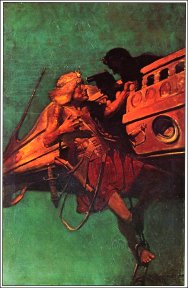
This image came from the Frank E. Schoonover dust jacket cover for the Gods of Mars (September 1918). It depicts the opening lines of chapter 6. John Carter has disguised himself wearing the blonde wig of a Holy Thern and has just escaped from pursuers. Trying to avoid a raging battle on the ground, Carter has jumped and grabbed a trailing ladder, pulled himself up trying to gain the deck of a Martian flier, when one of the Black Pirates of Barsoom spots him as his head comes level with the deck. "For an instant the black pirate and I remained motionless, glaring into each other's eyes. Then a grim smile curled the handsome lips above me, as an ebony hand came slowly in sight from above the edge of the deck and the cold, hollow eye of a revolver sought the centre of my forehead."
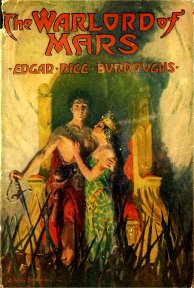
J. Allen St. John (1872-1957) was one of Burroughs' favorite illustrators. His first ERB art was his pen-and-ink illustrations for the 1915 The Return of Tarzan, and over the decades St. John painted and drew many classic images of John Carter, the incomparable Dejah Thoris, the princess of Mars, and their various adventures. The first illustration set on Barsoom by St. John was for the dust jacket of The Warlord of Mars (September 1919). The same image in monochrome serves as the frontispiece. St. John has chosen to illustrate the final page of the book, the triumphant finish to the three volume trilogy which began with A Princess of Mars. At the very end of the book the leaders and rulers of the separate nations, the red, the green, the yellow, and the black, have come to the capital city of Helium, surprised John Carter by summoning him to a justice tribunal, and Tars Tarkas, the ruler of the Thark nation asserts:
"Judges," he said, "there can be but one verdict. No longer may John Carter be Prince of Helium" - he paused - "but instead let him be Jeddak of Jeddaks, Warlord of Barsoom!"
... Presently fifty of the mightiest nobles of the greatest courts of Mars marched down the broad Aisle of Hope bearing a splendid car upon their shoulders, and as the people saw who sat within, the cheers that had rung out for me paled into insignificance besides those which thundered through the vast edifice now, for she whom the nobles carried was Dejah Thoris, beloved Princess of Helium.
Straight to the Throne of Righteousness they bore her, and there Tardos Mors assisted her from the car, leading her forward to my side.
"Let a world's most beautiful woman share the honor of her husband," he said. Before them all I drew my wife close to me and kissed her upon the lips.
Originally St. John painted this image as the color dust jacket cover, with St. John's own distinctive lettering painted onto the canvas. If you examine the print carefully, you can see the remnants of the original lettering which St. John has apparently painted over so that the image could be used for a monochrome frontispiece, but was not quite able to get rid of all traces of it.
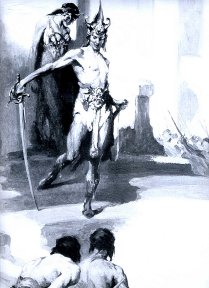
One of the most imaginative of the John Carter of Mars series is the fifth volume, the The Chessmen of Mars (November 1922). J. Allen St. John provided the dust jacket and eight sepia interior plates. This is the frontispiece of the first edition, wherein Turan has rescued Tara of Helium, the daughter of John Carter and Dejah Thoris, from a forced marriage. This grey and white oil painting perfectly captures the self-confidence of the swordsman, the beautiful woman he stands before and protects. Their clothing is regal, and the ancient throne room is brought to life by St. John's skill. It does not require much imagination to see this as John Carter and Dejah Thoris, if we wish.
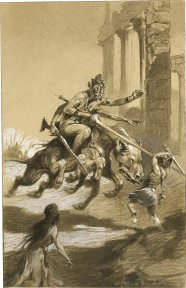
The first Mars book for which St. John provided numerous interior illustrations was the fourth book in the series, Thuvia, Maid of Mars (1920). This J. Allen St. John image is one of the great iconic portrayals of Barsoom. Contained in this single image are all the emblems of Barsoom. There is the six-limbed green warrior on his mount, a thoat. The red-skinned warrior, sword in hand, is ready to fight to protect the princess standing to the side. We cannot quite see her face, but from her stance and her flowing long hair, we know that she is extraordinarily beautiful, as befits a Burroughs heroine and princess. Additional green warriors are off in the background on the left. Ruins of an abandoned city lost in the past provide silent witness to the battle. This artwork is a favorite of many ERB fans and collectors. It served as the frontispiece for Thuvia, Maid of Mars (1920). The caption reads "As the great thoat and his rider hurtled past, Carthoris swung his long-sword in a mighty cut [Page 170]." The original artwork is monochrome; Philip Normand (of recoverings.com) digitally added color to enhance this portrayal of Barsoom.
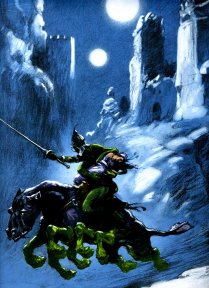
This J. Allen St. John image is also from Thuvia, Maid of Mars. The scene depicted on page 55 of the McClurg first edition is "Then Thar Ban vaulted to the back of this thoat, Thuvia of Ptarth still in his arms, and with a savage cry of triumph, disappeared down the black canyon of the Avenue of Quays between the sullen palaces of forgotten Aanthor." Although the original is monochrome, Philip Normand (of recoverings.com) has added a color underpainting to the original drawing allowing us to see and appreciate the image in a new way.
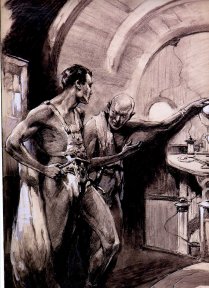
In an interior plate facing page 86 of the first edition of Swords of Mars (1936), J. Allen St. John portrays Fal Sivas, the inventor, showing John Carter the artificial brain (sixty years later we would call it a computer) which pilots the space ship. "Fal Sivas reached up and laid a hand almost affectionately upon the spherical object to which he had called my attention. 'This,' he said, 'is the brain'." The original work of art is in the possession of ERB, Inc.
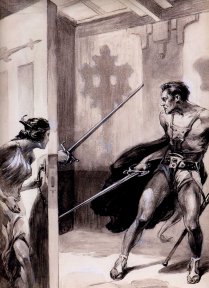
This image is among several of St. John's iconic visions which are in the collection of Edgar Rice Burroughs, Inc. and are found in this portfolio. This illustration faces page 158 is the first edition of Swords of Mars (1936): "A sword flashed inward." Although it could have been John Carter and Dejah Thoris, it is not. But we know that it must be Barsoom.
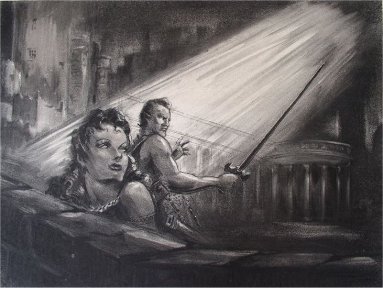
John Coleman Burroughs (1913-1979) provided illustrations for many of his father's books, including the ninth and tenth in the series set on Barsoom: Synthetic Men of Mars (1939) and Llana of Gathol (published in 1948 but written in 1940 before the Second World War broke out). Here John Coleman Burroughs gives us his vision of John Carter and Dejah Thoris. Scholars think it most likely that the model for Dejah Thoris was his wife, Jane Ralston Burroughs, who appeared in many of John Coleman Burroughs's paintings. She was also the model for Dejah Thoris in various comic strips, especially "John Carter of Mars" which John Coleman scripted and drew between 1939 and 1943.
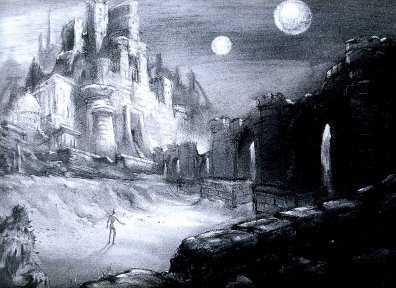
We know we are on Barsoom when we see two moons hurtling overhead. In this previously unpublished artwork by John Coleman Burroughs, we have an atmospheric rendering of what remains from a mighty empire of the past, the great city abandoned to decay and ruin when the ocean waters receded over the centuries. I think we can safely assume that the human in this work is John Carter about to embark on another of his adventures, quite possibly to rescue a lovely and feisty damsel held captive by the tribe of green warriors called the Warhoons.
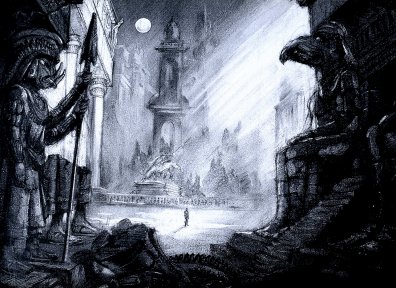
Another unpublished work by John Coleman Burroughs. John Carter has entered the ruined city of the previous plate, and apparently has worked his way over collapsed buildings and crumbling pathways to finally stand in the middle of what once was the center of a grand bustling city. Looking at the decaying sculpture and the fading art, Carter wonders about the people who built this grand structure.
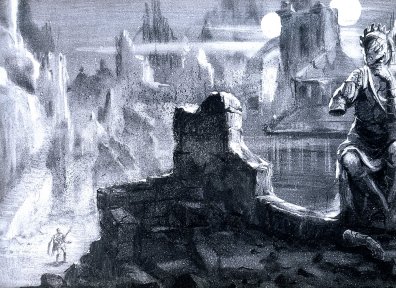
John Coleman Burroughs gives us the deathly silent interior of the eerie ruined capital. Who, or what, is that great statue on the right? Are white apes around the corner, about to attack? Are Warhoon green warriors nearby, taking aim with their deadly weapons?
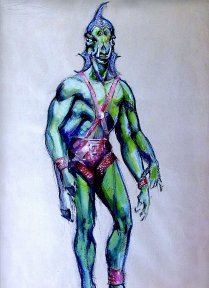
From the Edgar Rice Burroughs, Inc. collection we have John Coleman Burroughs' impression of Tars Tarkas, the green leader of the Thark tribe who became one of the best friends of our hero, John Carter. ERB described the green warriors as having a glossy green hide, and here John Carter describes a group from chapter 1 of the Gods of Mars:
... here were the gleaming white tusks protruding from their massive lower jaws to a point near the centre of their foreheads, the laterally placed, protruding eyes with which they could look forward or backward, or to either side without turning their heads, here the strange antennae-like ears rising from the tops of their foreheads, and the additional pair of arms extending from midway between the shoulders and the hips.
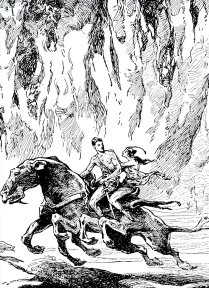
J. Allen St. John was a master of black ink drawing, and the original magazine appearances of ERB's stories published in the 1940s are filled with drawings like this. This classic image is found on page 25 of the controversial "John Carter and the Giant of Mars" which appeared in the January 1941 issue of Amazing Stories magazine. (A description of the controversy is found on page 73 of Robert Zeuschner, Edgar Rice Burroughs: The Exhaustive Scholar's and Collector's Descriptive Bibliography, McFarland, 1995).
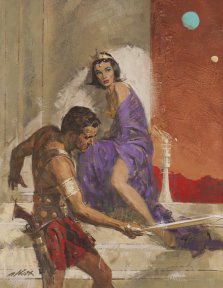
In the 1960s Ballantine Books issued the entire eleven-book series in paperback with interesting covers by Robert K. Abbett (b. 1926). Here Abbett provides the cover for the first U.S. paperback printing of A Princess of Mars (January 1963). Mr. Abbett continues to be an active painter, famous for scenes of nature and for his artworks featuring dogs in their native environment.
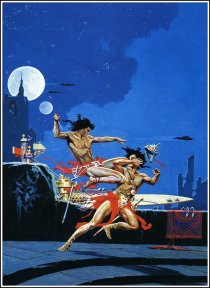
One of the great illustrators of the fantasy realms of Edgar Rice Burroughs was Roy G. Krenkel (1918-1983). Krenkel was a master of the pen-and-ink style but here he has produced an action-filled and colorful battle scene on Barsoom for the cover of the 1963 Ace paperback book, A Fighting Man of Mars. Apparently Frank Frazetta also contributed to this artwork. We want to thank the Krenkel estate for giving us permission to use this fine work.
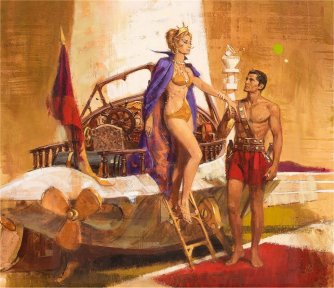
In this illustration for the Ballantine paperback, Thuvia, Maid of Mars, Robert K. Abbett portrays Thuvia of Ptarth descending from her flier. This illustration was withheld by the publisher until the 1969 reprinting.
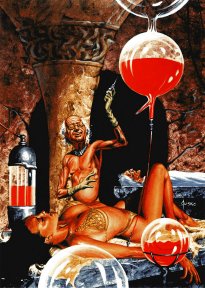
One of the contemporary artists who has contributed many excellent Burroughs fantasy art pieces is Joe Jusko (b. 1959). Although the subject matter of his art covers a broad field of subjects, Mr. Jusko has illustrated many dozens of artworks set on Barsoom. This image from 1995 belongs to Edgar Rice Burroughs, Inc., and depicts Ras Thavas, a medical experimenter whose brilliance is the result of natural genius plus a thousand years of discoveries resulting from his continuous practice in the operating theater. He is also known as the Master Mind of Mars. Using his own inventions including a blood pump, he is about to perform an operation on a woman of the red race of Helium.
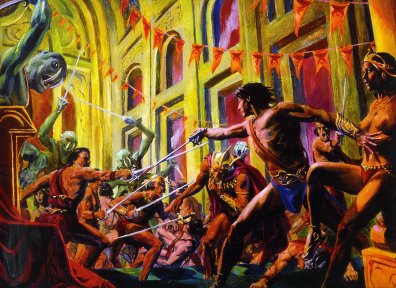
Thomas Yeates (b. 1958) is one of several gifted contemporary artists who loves to illustrate ERB. Thomas began illustrating Burroughs books while still quite young, contributing to Burroughs fan magazines. Here we have the climatic battle at the end of A Princess of Mars. The mighty nation of Zodanga has fallen to tribes of green warriors as well as the red warriors of the city of Helium, united in common purpose by John Carter. The goal is the rescue of Dejah Thoris from the Jeddak (ruler) of Zodanga. We recognize John Carter and Dejah Thoris in the throne room as the climatic battle rages.
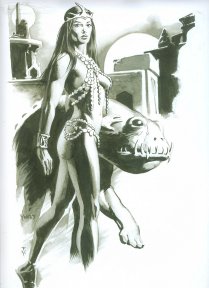
Thomas Yeates provided this interior illustration of Dejah Thoris and Woola, which appears on page 88 of the collection, John Carter of Mars (Fall River Press, 2009). The scene is from A Princess of Mars and the caption is "She moved with the carriage of the queen she was." A Hollywood star served as the model for Dejah Thoris. From the collection of Bob and Lindy Zeuschner.
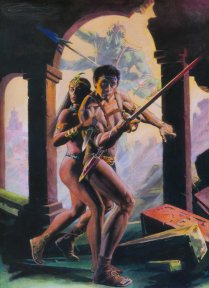
This previously unpublished art by Thomas Yeates combines the major icons of the Barsoom series of books. We see John Carter, Dejah Thoris, and Tars Tarkas exploring another decaying city of ancient Barsoom. This is in the collection of Bob and Lindy Zeuschner.
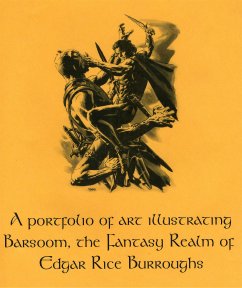
The art on the envelope is by Thomas Yeates and appears on page 69 of the combined volume, John Carter of Mars (Fall River Press, 2009). It depicts a scene found in chapter 10 of A Princess of Mars: "Springing upward, I struck him full in the face as he turned at my warning cry, and then as he drew his short-sword I drew mine and sprang up again upon his breast, hooking one leg over the butt of his pistol and grasping one of his huge tusks with my left hand while I delivered blow after blow upon his enormous chest."
- The compiler of this portfolio and the author of these notes is Dr.Robert Zeuschner.
- The compiler wishes to thank Jim Sullos and Cathy Wilbanksat ERB, Inc. for so generously making available images of the wonderfuloriginal Burroughs art which is in their care.
- The late Danton Burroughs shared numerous images of his father'sworks and asked me to make them available. I'm glad to finally have theopportunity to do so.
- Two members of the Los Angeles branch of the Burroughs Bibliophiles,the SubERBs, were especially instrumental in bringing this portfolioto you. Special thanks are due to Billy York and Bonnie York.
- Several works of art in this portfolio were not in the ERB, Inc. collection,and the compiler wishes to thank Bill Hillman, Philip Normand,Bruce Bozarth, and Charles Madison for their work on variousscans. The pulp magazine covers and interior art come from the collectionof Bob Zeuschner.
- Thanks to Barry Klugerman, who controls the RG Krenkel estate,for permission to use the Krenkel image.
- A special thanks to Thomas Yeates who so very generously sharedhis art, and who made it possible to get permission from the Krenkel estateto use the Roy Krenkel image. All of the Thomas Yeates artworksin this portfolio were used with his permission.
- Thanks also to the person who worked behind the scenes, but who was neverthelessinstrumental in creating the portfolio as you see it: Brian Kirby.
- Finally, Javier Dimas of AFJ Graphics worked long and hardon the project, improving the scans wherever he could and patiently makingthe many changes as we went along. Thank you, Javier.
100 Years of Tarzan Classic and Contemporary Images of Tarzan of the Apes
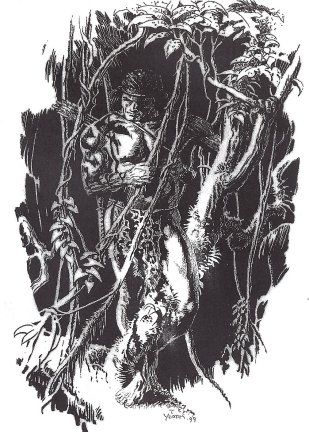
By Dr. Robert Zeuschner
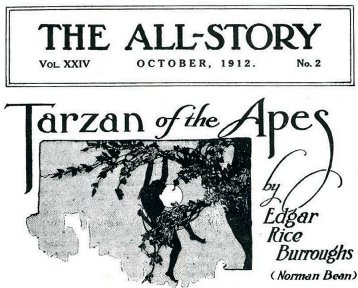
This portfolio is a celebration of the 100th anniversary of the 1912 appearance of Tarzan in The All-Story magazine.
With the publication of this tale Edgar Rice Burroughs was on his way to becoming the reigning king of pulp magazine fiction for the next twenty years.
The Tarzan story was Burroughs' second published work, an imaginative tale of the infant child of British nobility raised on the west coast of Africa by a small group of primates whose species remains as yet undiscovered by primatologists.
Tarzan went on to become one of the bed rocks of popular culture worldwide.
Author Harlan Ellison is quoted as follows:
"If one of the unarguable criteria for literary greatness is recognition, consider this: in all of the history of literature, there are only five fictional creations known to every man, woman, and child on the planet. The urchin in Irkutsk may never have heard of Hamlet, the peon in Pernambuco may not know who Raskolnikov is; the widow in Jakarta may stare blankly at the mention of Don Quixote or Micawber or Jay Gatsby. But every man, woman, and child on the planet knows Mickey Mouse, Sherlock Holmes, Tarzan, Robin Hood... and Superman."
This portfolio of quality lithographs is an attempt to capture some of the best examples of Tarzan art over the past century in just twenty plates. The contradictory criteria for inclusion in this portfolio made the task of compiling it especially difficult. We wanted enduring and iconic images, but at the same time we also wanted images which were not reproduced often.
However, the truly iconic images have been reproduced over and over for good reason. These enduring artworks are not only beautifully executed, but they capture something essential to the character or world of the ape-man. So, even though many of these classic images are available elsewhere, we still felt they deserved this large format.
A much more difficult task is trying to find uncommon yet high quality Tarzan art. Because of the proliferation of Burroughs websites, just about every image is available. However, we hope there might be a few of these plates that you have not seen before. Many of the original artworks in this portfolio belong to Edgar Rice Burroughs, Inc. and hang on their walls. This is especially true for the many J. Allen St. John plates.
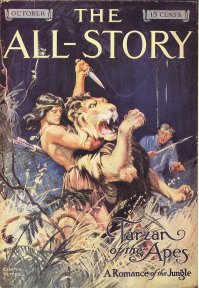
The portfolio begins with the first published image of Tarzan of the Apes and, appropriately enough, features both the ape-man and a lion. The artist was Clinton Pettee (1872-1937) and it was on the cover of the October 1912 issue of The All-Story. Many of the elements essential to the Tarzan legend are present in this work, and numerous later interpretations of the scene have been represented several times in the intervening hundred years, including other plates in this portfolio. Tarzan fights a lion to save the life of a stranger who, in this case, turns out to be his cousin, Cecil Clayton. The well-worn magazine is from the collection of Bob and Lindy Zeuschner.
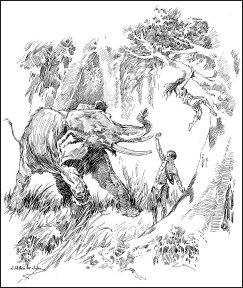
The fourth Tarzan novel, The Son of Tarzan (published in March 1917), is filled with wonderful interior pen-and-ink art by the great J. Allen St. John (1872-1957). This full-page image depicts a tension-filled scene featuring Tarzan of the Apes fresh from London with short hair, Tantor the elephant, and the lovely Meriem. Korak the Killer, the son of Tarzan and Jane, has been tied tightly to a stake and although Tantor has carried him away from danger, he will starve to death soon if he cannot get free. Meriem comes to untie Korak, but Tantor the elephant does not recognize her as a friend. Tantor charges. Meriem turns and flees, trying desperately to reach the safety of the nearest tree, but the elephant is too quick. She cannot escape. It seems hopeless.
A dozen more strides and the brute would seize her. What was that? Korak's eyes started from their sockets. A strange figure had leaped from the tree the shade of which Meriem already had reached-leaped beyond the girl straight into the path of the charging elephant. It was a naked white giant. Across his shoulder a coil of rope was looped. In the band of his gee string was a hunting knife. Otherwise he was unarmed. With naked hands he faced the maddened Tantor. A sharp command broke from the stranger's lips-the great beast halted in his tracks-and Meriem swung herself upward into the tree to safety. ... "Father!" came chokingly from The Killer's lips. "Thank God that it was you. No one else in all the jungle could have stopped Tantor." (The Son of Tarzan, A. C. McClurg & Co., pp. 383-385).
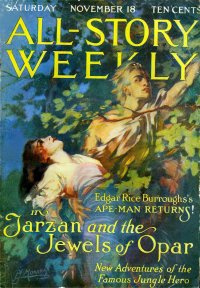
This plate was the front cover for the November 18, 1916 issue of the All-Story Weekly serial for the fifth Tarzan novel in the series, "Tarzan and the Jewels of Opar." This is an uncommon image rarely seen in full color. In this oil painting, the artist, P. J. Monahan (1882-1931) gives us a blonde Tarzan wearing something rather unusual, and effortlessly carrying Jane through the treetops. Artist David Adams reacts to this: "We sometimes forget what a romantic writer ERB really is. ... the love of Tarzan and Jane is an epic American romance in the best tradition. This image is simply burning with passion."
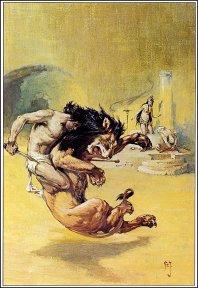
In this painting, J. Allen St. John (1872-1957) portrays an encounter between Tarzan and a lion, and it served as the dust jacket cover for the hardcover Tarzan and the Jewels of Opar (1918). Burroughs describes the unequal battle scene on pages 73-75: "He saw the lion snapping and tearing at the weapon's shaft, and he saw, wonder of wonders, the naked giant who had hurled the missile charging upon the great beast, only a long knife ready to meet those ferocious fangs and talons ... By a quick side step, Tarzan eluded the first swinging clutch of the lion's paws. Darting to the beast's side, he leaped upon the tawny back." This is one of those classic images which has been verypopular from the earliest years. Artist David Adams notes, ". . . the great thing about this painting is the fact that St. John transforms Tarzan and the lion into one circular being. His arm echoes the lion's arm, his black hair is in the lion's black mane. ... In the background La interrupts her sacrifice in homage to a greater one taking place before her. Despite the violent action, this painting is as still as an icon, which gives it a religious kind of power. ... This painting is a great symbol with a wealth of interpretations available. It is an inspired work of art." The original oil painting which measures 18.5 x 28.5 hangs on the wall behind the desk of the president of Edgar Rice Burroughs, Inc. and Danton Burroughs once told me that it was a personal favorite of his.
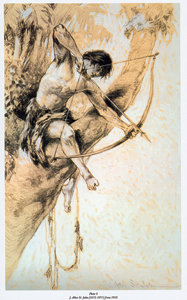
This classic J. Allen St. John (1872-1957) image is the frontispiece from the 1918 hardcover first edition of Tarzan and the Jewels of Opar. It is one of those iconic images which perfectly captures the grace and physical strength of Tarzan. Burroughs describes it thus: "Then Tarzan fitted an arrow to his bow, and drawing the slim shaft far back let drive with all the force of the tough wood that only he could bend." [A. C. McClurg, 1918, page 182]. David Adams responds to this St. John art with appreciation: "The genius of this work is the perfect balance of tensions between Tarzan drawing his bow while sitting on an arching limb of a great tree. His slightly bent toe tells the story of the balance achieved with the arm drawing the arrow (albeit on the wrong side of the bow!). Tarzan leans his left elbow against the tree to steady his aim while his left leg dangles as relaxed as the nearby vines. Again, Tarzan's face is nearly impassive with but a slight smile at the corner of his lips. ... It is youthful grace and power about to give release with his whole body that will never relax from its eternal, breathless tension. Another inspired work by St. John." Artist Dan Parsons reacted, "A charcoal drawing on a toned ground. St. John applied white charcoal on the mid-tone ground to create the highlights. Very 'Old Masters' approach. Michelangelo-Raphael-Da Vinci all used this."
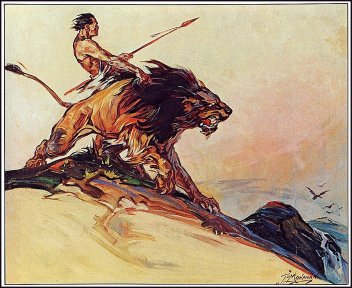
This plate contains two images of the same scene by two great artists separated by almost fifty years. These both feature Tarzan striding side-by-side with his wild companion, with the lion front and center. From the December 9, 1922 issue of Argosy All-Story Weekly we have a powerful colorful image by artist P. J. Monahan (1882-1931). Monahan produced the cover art for the first issue of the serial "Tarzan and the Golden Lion," an image of Tarzan and Jad-bal-ja, his golden lion companion, as they travel through the world of lost empires and dangerous jungles. We can feel Tarzan trying to restrain the incessant pull of the golden lion. Artist Philip Normand observes that "one thing that makes the Monahan so good is that he has captured a strong sense of movement and force ... The angle and tension in the arm and back of Monahan's Tarzan shows a resistance against the massive power of the lion." Indeed, these make a savage pair in this artwork.
The second version of this scene is by artist Roy G. Krenkel (1918-1983) who produced numerous Ace paperback book covers as well as hundreds of pencil and ink sketches of Burroughs related art. Roy drew this particular tableau of Tarzan and the golden lion several times, including one entirely in pencil. ERB, Inc. commissioned this and it was delivered on June 29, 1966, when it was adopted as the official corporate logo. Krenkel patterned this highly stylized work after the Monahan depiction in this portfolio, but Krenkel has done it masterfully in the pen-and-ink style that reminds us of St. John (Plate 8) and so it can serve as an homage to both. There is lovely fine detail in this 15.5x10.5 artwork. It hangs on the wall in what used to be the office of the late Danton Burroughs.
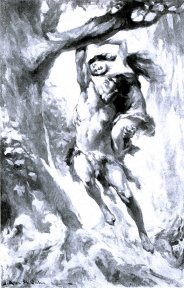
In an effort to include as much classic art as possible, we have presented a triptych of three St. John pieces. On the left is an image from the 1923 first edition of Tarzan and the Golden Lion, where Tarzan has just rescued the baby lion cub who will grow into the mighty Jad-bal-ja. The center art is from the 1921 Tarzan the Terrible, where Tarzan is mistaken for a divinity by the tribe in the lost land of Pal-ul-don. The image on the right is the first edition frontispiece from the 1928 Tarzan at the Earth's Core where we can see Tarzan springing into the trees with what could be Jane on his shoulder. David Adams points out that St. John has captured some very theatrical gestures, and turned them into fine art. Although we have not seen the originals, artist Dan Parsons theorizes that it is likely they were done as "... monochromatic oil paintings in burnt umber (sepia). Just beautiful."
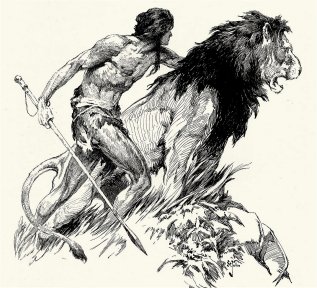
If there is one ultimate and defining work of art that captures the natural savage beauty and grace of Tarzan, it is this large 1923 pen-and-ink drawing by the great J. Allen St. John: "Hunting together, the man and the great lion trod the paths toward home." Instead of the lion, it is Tarzan himself who is front and center. The owner reports that the image is approximately 20"x30" and was drawn on Masonite. The theme is the same as the two images on Plate 6, but envisioned quite differently. St. John has captured serenity and camaraderie as the friends slowly make their wandering way towards home. Artist David Adams says, "One need hardly point out the beautiful way the man and lion echo each other in their stance, nor the echo of the lion's tail and Tarzan's spear. There are so many wonderful things going on here, that it would take an entire article to mention them all. Placing Tarzan on the viewer's side gives the Ape-Man enormous presence and weight that makes him the beast's equal. He is not pulled along here but acts as a guide. There is no doubt as to who is in control. Tarzan notices something in the distance that even the lion does not see. A supreme masterpiece." Dan Parsons comments, "The subtlety of the fine line is reminiscent of the etchings of the early 19th century. Extremely difficult to master this!" This image served as the basis for the dust jacket cover for the 1923 Tarzan and the Golden Lion.
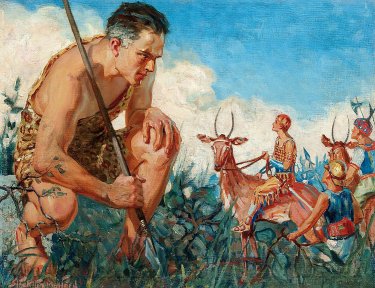
This is Stockton Mulford's (1886-1960) cover art for "Tarzan and the Ant Men" in the February 2nd 1924 issue of Argosy All-Story Weekly. This issue was the first part of a seven-part serial. Tarzan's son teaches his father to fly an airplane, and on his first solo flight Tarzan crashes and winds up in the land of the Minunians who are only about 18" tall. There are many features about this book which suggests fairy tales with grim subjects, and an extended morality play about what happens when the "proper" roles of men and women are reversed. Although the adventure was set in 1918 in the story, Stockton Mulford must have believed that Tarzan was a grandfather by now, depicting Tarzan with grey hair around his temples. If we assume that Tarzan really was born in 1888 (in Tarzan of the Apes, Burroughs tells us that Tarzan's parents sailed from Dover in 1888, and that Tarzan was born later in the same year), then Tarzan should have been about 30 years old in Mulford's portrait. In the year 2013 the ever-youthful Tarzan will celebrate his 124th birthday.
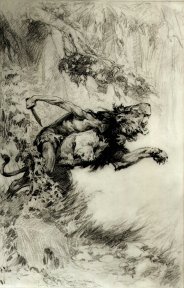
This distinctive and exciting illustration is another J. Allen St. John iconic image, but this time it is the ape-man fighting a lion. Although Tarzan's friend and companion through many adventures was Jad-bal-ja, the golden lion, in general lions often became a dangerous threat to the ape-man or others. On occasion Tarzan was compelled to face a lion armed only with his hunting knife. St. John did several versions of this type of battle (compare Plate 4). David Adams remarks: "It is nice to see St John's pencil drawings. He had a beautiful, delicate hand for pencil work that exploited the medium to the fullest. Here he expended a great deal of loving care on the foliage not often found in his pen and ink drawings. The 'single animal' concept here is very dramatic, especially the outstretched arms of man and lion. Tarzan pushes his face into the mane as he becomes one with the animal .... I find the branch over the struggling pair to be a touch of daring for the artist since you can easily imagine the picture as being complete without it." This St. John pencil drawing was an interior plate from the 1928 first edition of Tarzan, Lord of the Jungle. The original art is approximately 11.5 x 17.75" quite close to the size of the plate in this portfolio. The image was reproduced on page 60 in Stephen D. Korshak, The Paintings of J. Allen St. John: Grand Master of Fantasy (New York: Vanguard Productions, 2008). This piece is in the collection of Bob and Lindy Zeuschner.
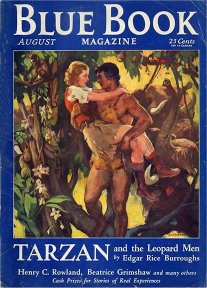
This quite romantic illustration by Joseph Chenoweth (1890-1967) appeared on the front cover of the August 1932 issue of Blue Book magazine. It was the first issue of the six-part serial with a cover illustrating "Tarzan and the Leopard Men." The tale is set in 1931 with Tarzan in the treetops and he has just rescued Jesse Jerome (but if we wish we can imagine her as the blonde Jane as described by ERB), and the moment is serene. Artist Dan Parsons responded, "A montage of photographic references pieced together in the manner of a Norman Rockwell painting." Blue Book magazine was a great source for dozens of excellent cover illustrations of Tarzan (as well as other Burroughs heroes and realms), and usually had interior line art by Frank J. Hoban (1870-1943), who also did numerous ERB cover issues not included in this portfolio due to lack of space.
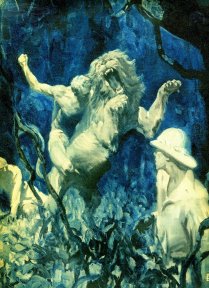
Artist Ray Dean (1886-1960) created numerous excellent interior illustrations for the nine-issue Tarzan serial, "Tarzan and the Lion Man" published in Liberty magazine between 1933-1934. This extraordinary image is from the December 2nd, 1933 issue. This is another of the classic encounters with Tarzan fighting on the back of a lion. The color-tinted black-and-white wash artwork set in nighttime is very dramatic and compelling. Dean's Tarzan art is not well known, and indeed, details about the artist and his life are hard to find. Burroughs art scholar Robert R. Barrett has assured us that an article on Dean's art and life appears in ERBANIA 102 (October 2012).
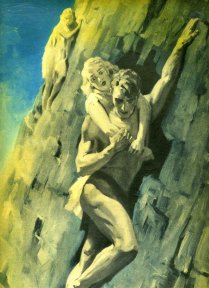
This tension-filled illustration from the January 6th, 1934 issue of the Liberty magazine serial of "Tarzan and the Lion Man" is also by Ray Dean. In this tale Burroughs pokes fun at Hollywood producers and directors and their rather lame attempts to make Tarzan movies. Here we have Tarzan navigating a sheer cliff which neither you nor I could climb alone, and yet Tarzan is carrying the rescued movie actress Rhonda Terry on his back. The wild jungle girl, Balza, her long blonde hair streaming over her body, follows them. David Adams notes, "The blue-green tinting over his black and white painting works extremely well, presenting a harrowing nightmare of Tarzan making a climbing traverse on a sheer cliff carrying a woman on his back. She is obviously terrified, while he calmly chooses a toe-hold while gripping a narrow ledge with his left hand fingers."
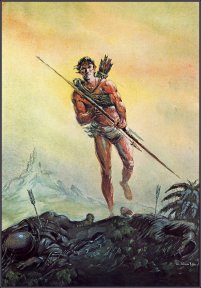
John Coleman Burroughs (1913-1979) illustrated a dozen books written by his father. One of his best works is from 1947 where he did this mixed media-gouache watercolor dust jacket illustration for Tarzan and 'The Foreign Legion' - a book set during World War II. The grim ape-man fights for the British and American forces and against Japanese forces in the Indonesian island of Sumatra. Dan Parsons approves of it: "Nice use of atmospheric perspective to push back Tarzan's right leg." This is from the ERB, Inc. collection.
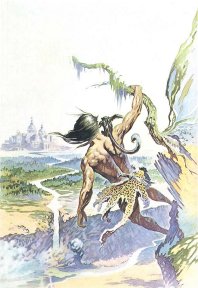
Even though he was neither a fan nor reader of Burroughs, there is general acknowledgment that Frank Frazetta (1928-2010) was one of the greatest of the contemporary artists to depict the fantasy realms created by Edgar Rice Burroughs. This is one of his earliest Burroughs works, from the November 1962 Ace paperback printing of Tarzan and the Lost Empire. Many important elements of the Tarzan mythos are here: the beautifully muscled Tarzan in his leopard skin loin cloth, his faithful N'kima, and a lost civilization, full of peril, to be explored. Tarzan's face is not seen, allowing us to fill in this important feature ourselves. David Adams says, "Everything is curves in this work, a lovely watercolor painting displaying his mastery of color and form. Tarzan's right wrist is casually looped over a tree branch as he leans precariously over the cliff -- not just for the view but in a devil-may-care attitude that reflects his supreme confidence in overcoming any new world he may enter." Dan Parsons echoes this, writing "The sensitivity of Frank Frazetta is unmatched." The original is not very large, and in fact is just 10"x15.5". This belongs to the ERB, Inc. collection.
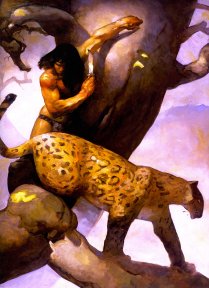
The late Jeffrey Catherine Jones (1944-2011) was one of the great fantasy artists, and a Burroughs reader as well. Jones freely contributed numerous Burroughs artworks to many Burroughs fanzines. In addition, Jones's remarkably expressionistic art filled a Burroughs calendar with extraordinary imagery ("Jeffrey Jones: 1998 Edgar Rice Burroughs Calendar" published by FPG of Pittsburgh, PA). The evocative Tarzan image in this portfolio was not in the FPG calendar and is uncommon. David Adams says of Jones, "His dark expressionism captures something unique in Tarzan's personality, a 'dark side' if you will, which is often described by Burroughs as his 'grim' sense of humor." Thanks to the efforts of Thomas Yeates, we were able to obtain the art and the permission of the estate of Jeffrey Jones to include it here.
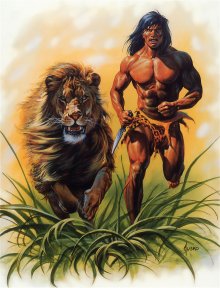
This image by Joe Jusko (b. 1959) entitled "On the Run" is another which exemplifies the camaraderie between the ape-man and Jad-bal-ja, the golden lion. Mr. Jusko's dynamic Burroughs art was featured in the 1994 set of 125 Edgar Rice Burroughs collectible trading cards, and in 1996 those images appeared in Joe Jusko's Art of Edgar Rice Burroughs (Pittsburgh, PA: FPG, 1996). This particular image is featured on page 11 of the book. Over the years Jusko continues to return to Burroughs subjects and themes. The original is 8.5 x 11.5.
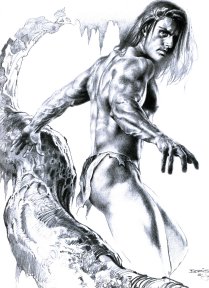
This finely detailed pencil drawing of Tarzan is by the great artist team of Boris Vallejo and his wife, Julie Bell, who have provided quality cover illustrations for numerous books by Edgar Rice Burroughs. The original drawing is approximately 14"x18". It was commissioned following a 2002 Burroughs convention and was included in Boris Vallejo and Julie Bell: The Ultimate Illustrations (Harper Design, 2009). It is from the collection of Bob and Lindy Zeuschner. We thank Mr. and Mrs. Vallejo for giving us permission to include this fine work in the portfolio.
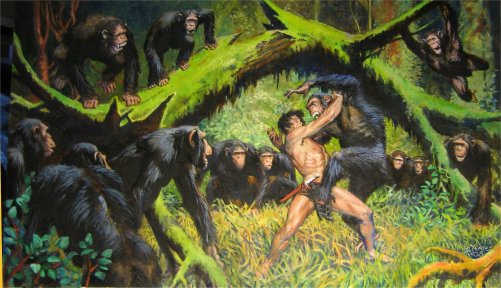
Artist Thomas Yeates (b. 1955) is a life-long Burroughs reader and has been drawing Burroughs related art for decades. In addition to comic strips for Prince Valiant and Zorro, he has illustrated Tarzan comic books and a beautifully illustrated John Carter trilogy (John Carter of Mars: A Princess of Mars/The Gods of Mars/The Warlord of Mars, Fall River Press, 2009). David Adams writes of this piece, "He captures the spirit of St. John in his work and all the great Tarzan artists since as well. He is a brilliant artist with formidable artistic abilities that are combined with a deep knowledge and love of his subject." Thomas created this depiction in 2008, which he entitled "Duel for Dominance." It is used with permission of the artist.
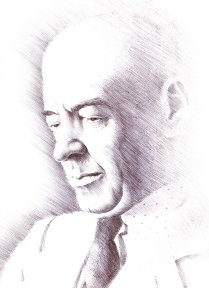
This thoughtful and subtle previously unpublished image is of Edgar Rice Burroughs (1875-1950), the author who created Tarzan of the Apes. In 1999, artist Ron Jiminez was commissioned to do this drawing of Burroughs, which is in the collection of Bob and Lindy Zeuschner.
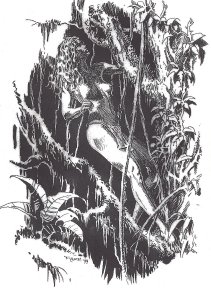
The original Tarzan art on the envelope is a 10" x17" jungle scene by Thomas Yeates and is one-half of a diptych set in the same jungle environment. The other half of the original piece portrayed Jane looking up at her mate. . . it has been added to this page.
- The portfolio art and notes were compiled by Dr. Robert Zeuschnerand printed in July 2012 to be shared at the annual Burroughs "Dum-Dum"convention August 16-18, 2012.
- We would like to thank Edgar Rice Burroughs, Inc., especially thePresident, Jim Sullos, and Cathy Wilbanks, Tyler Wilbanks,JanetMann and Willie Jones for their ongoing help and cooperation.
- Thanks to Boris Vallejo and Julie Bell for generously allowingus to reproduce their Tarzan artwork.
- Thanks to Thomas Yeates for allowing us to use his art, and forobtaining permission to include the Jeff Jones piece.
- Thanks to Bruce Bozarth and Philip Normand, who shared theirideas and who improved several scans allowing them to be included in thisportfolio. Mr. Bozarth allowed us to use his dust jacket art as well.
- Thanks to Bonnie and Billy York for their many important contributionsto this portfolio including the beautifully printed envelope that containsthis set of
- lithographs.Thanks to Brian Kirby who supplied ideas and reactionsto ideas that made the portfolio better.
- Thanks to artist, musician and Burroughs scholar David Adams, whokindly shared his enthusiasm for and appreciation of the artwork in thisportfolio and gave me permission to quote him.
- Artist Dan Parsons shared his reactions to the various plates, andwe thank him for allowing us to paraphrase and quote from his words.
- The various magazine covers and interior art come from the Zeuschnercollection.
- Javier Dimas of AFJ Graphics put in many extra hours working oneach scan and ensured that they would look as good as possible. Thank you,Javier.





